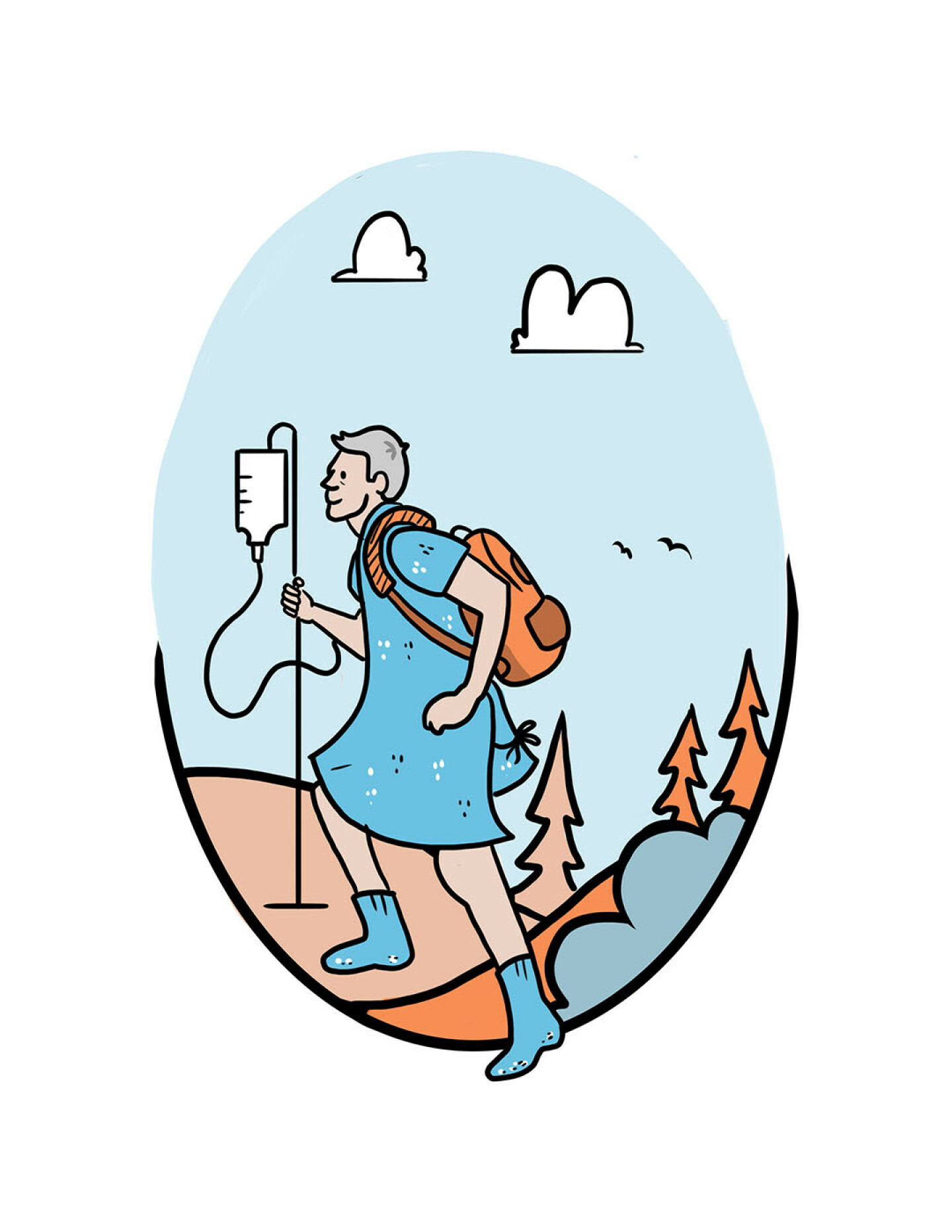
COLUMN: Lacing Up for a Mental Hike
staying calm inside an MRI is as easy as a walk in the woods
Dan Lyksett, illustrated by Lydia “Nibs” Noble

I must watch my step. The trail is tricky here. Ruts left by logging trucks lurk in the tall grass, waiting to send the unwary sprawling with a twisted ankle. Nearing the top of the ridge the trail mellows to even, packed gravel. A few more steps, and I’ll be able to see across a swamp to a place on the ridge we call The End because, well, it’s the end of that ridge.
In a dry year I can take a shortcut to The End by scrambling through that tangle of tag alder. But I’ve decided there’s been plenty of rain this summer. Controlling the weather is a super power I possess because I’m not actually hiking in the Washburn County forest. Instead, I’ve been packed tight like a precious vase about to be shipped and then encased in a clamorous sarcophagus-like machine for a test called Magnetic Resonance Imaging. And I’m trying to keep my wits about me.
A couple years ago, while looking for one thing, the good doctor found another: A small, benign growth attached to my brain. No worries, the good doctor assured me, it’s probably nothing. We’ll just keep an eye it.
“Keeping an eye on it” meant an annual journey into the bowels of an MRI machine.
A handout says MRI patients must remain very still in an enclosed space for extended periods of time. It notes people who experience intense anxiety or claustrophobia may benefit from taking prescribed sedatives before the procedure.
”
(THE MRI) is big and round with a hole in the middle. I am being fed to a gigantic, carnivorous donut.

DAN LYkSETT
Before my first MRI, I decline the sedatives since I do not experience intense anxiety or claustrophobia. And I am a male raised in the shadow of the Greatest Generation, so even if I did experience intense anxiety or claustrophobia, I will deny it. Rules are rules.
So the night before my first MRI, I lie in bed and wonder, “What if I couldn’t even sit up right now?” conjuring up some pretty good anxiety.
The next day, draped in hospital attire and bereft of all metal objects, I am secured on a gurney resting on metal tracks and, with the kindly nurse offering “Here we go,” I slowly slide headfirst into the machine.
It is big and round with a hole in the middle. I am being fed to a gigantic, carnivorous donut.
It is very close in here. The nurse asks over an intercom: Are you OK? I reply, Yup, and then proceed to figure out how to be OK.
I consider options short of whimpering like a lost puppy before settling on taking a mental hike. I choose a trail I’ve walked several times almost every year since 1975. It leads into deep woods where in November we hunt deer. I’ve trekked this trail in all weather, in all seasons. I know this trail.
I am very intentional as I recreate that walk. I imagine each step, picturing minute changes in terrain and footing. I occasionally scan the canopy or take note of the call of a crow. Eventually I pause where the trail splits, consider heading east where the moraine is more dramatic or north where three old, massive pine trees keep company, surviving. I choose the pine trees.
But as much as I focus on the small details, other larger thoughts occasionally intervene. At one low spot on the trail, I remember a deer season where I find a bobcat track on the hoar frost. The next morning the cat screams at me from somewhere in the predawn darkness.
Then I arrive at a place we called “Trailhead,” a rendezvous spot where during the hunt we would gather at midday to eat sandwiches and talk. Back then there were five of us. One has since moved out of state. The other three have crossed over. I am the last man standing.
I refocus on my next step. And the next one. And the one after that. And suddenly the voice of the kindly nurse comes over the intercom: All finished. The gurney jerks back to life, and I begin the ride back to reality.
And in a way, I am disappointed. I would have liked to see those old pine trees.